Explained: The experimental F1 qualifying format which will debut at Hungarian Grand Prix

As part of F1’s move to become more sustainable, alongside Pirelli, they’re looking to reduce the amount of tyres available to each driver at a given weekend.
As a result, a new qualifying format will take place this weekend at the Hungaroring.
The 'Alternative Tyre Allocation' will only be trialled at two race weekends in F1 2023.
How will it work?
Quite simply, drivers are mandated to use a certain tyre in the three qualifying segments.
Q1: Only the hard tyre can be used.
Q2: Only the medium tyre can be used.
Q3: Only the soft tyre can be used.
This will only apply if the session is dry, otherwise teams will have free choice.
The format is similar to the one used during sprint weekends.
In the sprint shootout on Saturday morning, drivers can only use hards in Q1, mediums in Q2 and softs in Q3.
Why Hungary?
Originally, the format was going to debut at Imola, however, due to unforeseen flooding in the Emilia Romagna region, the race was cancelled.
The format is expected to be tested again at Monza in September.
Why the new format?
It’s a move to reduce the number of tyre sets each weekend.
In Hungary, drivers will only have 11 dry tyre sets available, rather than the usual 13.
This quickly adds up as it's 40 sets of tyres saved across the whole grid or 160 individual tyres meaning that over 3600 tyres in total that would be saved throughout an entire season if the format was implemented at each event.


